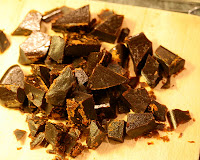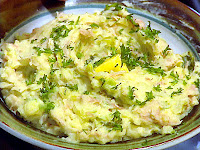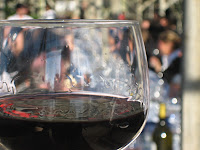Now, those who know me are well aware of my love for tequila. I do not drink tequila often, but when out socializing, it is my drink of choice and I probably drink it more than most. That is, of course, unless you are still in Mr. or Ms. Party Mode and are the "
Hey let's do shots!" type. Been there...done that. You'll get over it. Fortunately for me, I have developed a resistance to tequila's inebriation effects and seem to be able to consume it without damaging brain cells. Well, ok, that is at least a factual statement ever since I decided to start acting like a grown up in public. Look, that's my story and I'm sticking to it.
At this stage in my life I have become a fan of the taste of tequila and the only true way (
for me) to enjoy that aspect of tequila is to sip it, in the same way one might sip a brandy, or a cognac. Shots, on the other hand are for enjoying the
effects of tequila. Far be it from me to tell you what you should or should not derive from your personal interaction with this ancient elixir. To each his own. If you see me out, please don't challenge me to a shot contest. I said, "acting like a grown up, it doesn't mean I am one.
Whatever your fascination with tequila, I will explore every angle, from the agave plant, its history, cultivation and processing, all the way through to the finished distilled product. I will even give you step by step instructions on doing your own tequila tasting. Tomas Estes suggests that a champagne flute or any wine glass that is closed ended, or fluted at the top, will work. Not a shot glass!!! So without further ado, let's begin.
Agave
Say the word agave and most people automatically think, tequila. While technically correct, there are actually three distinct types of a plant named agave. The most familiar to all is the acclaimed Agave Azul, or Blue Agave, which, yes folks, indeed makes tequila and is the variety we will be focusing on today.
Chiefly Mexican, agaves occur also in the southern and western United States and in central and tropical South America. The plants have a large rosette of thick fleshy leaves, each ending generally in a sharp point and with a spiny margin; the stout stem is usually short, the leaves apparently springing from the root. Along with plants from the related genus Yucca, various agave species are popular ornamental plants. Each rosette is monocarpic and grows slowly to flower only once. During flowering, a tall stem or "mast" grows from the center of the leaf rosette and bears a large number of short tubular flowers. After development of fruit the original plant dies, but suckers are frequently produced from the base of the stem which become new plants (pups). It is a common misconception that agaves are cacti. They are actually closely related to the lily and amaryllis families, and are not related to cacti at all.
The agave plant plays a much larger role than just being the source of an alcoholic drink. Its leaves are harvested for a hemp-like fiber that is used for mats, clothing, rope and paper. It was also the source of the nutrient and vitamin rich brew, pulque. The plant was aptly described as "el arbol de las maravillas" - the tree of marvels - in a 1596 history of the Indians of Central America. The agave plant has been part of human culture almost since the continent was first colonized and is still used for its fiber. Human remains dating back at least 9,000 years (some ethnobotanists say 11,000) show the early uses of agave. Here is a brief snapshot of three types so you can amaze your friends with your knowledge of obscure facts.
Agave Americana
One of the most familiar species is Agave Americana, a native of tropical America. Common names include Century Plant, Maguey (in Mexico), or American Aloe (it is not, however, related to the genus Aloe). The name "Century Plant" refers to the long time the plant takes to flower, although the number of years before flowering occurs depends on the vigor of the individual plant, as well as the richness of the soil and climate. During these years the plant is storing in its fleshy leaves the nourishment it will need for the effort of flowering.
Agave Attenuata
A native of central Mexico, it is uncommon in its natural habitat. Unlike most species of agave, it has a a curved flower spike from which it derives one of its numerous common names - the Foxtail Agave. It is also commonly grown as a garden plant. Unlike many agaves, it has no teeth or terminal spines making it an ideal plant for areas adjacent to footpaths. Like all agaves it is a succulent and requires little water or maintenance once established.
Agave Azul
It has a lifespan of 8-14 years, depending on soil, climate and cultivation methods, and will be harvested at between 8 and 10 years.That's about 3,000 days before the harvest, a long time to wait. A farmer who plants a one-year-old shoot (hijuelo) today, in 2012, won't even harvest it for tequila until at least 2021, and maybe as late as 2022. Then, if it's aged at all, it could take another one to five years before it appears on the shelf - 2023 to 2027. An agave is a one-time use. It's not like a grape where you can plant a vine and have grapes every year. Archeologists say agaves have been cultivated for at least 9,000 years, and used as food for even longer.
The tequila agave grows natively in Jalisco, favoring the high altitudes and sandy soil. Commercial and wild agaves
The flowers are pollinated by a native bat (Leptonycteris nivalis) and produce several thousand seeds per plant. The plant then dies. The shoots are removed when about a year old from commercial plants to allow the heart to grow larger. The plants are then reproduced by planting these shoots; this has led to a considerable loss of genetic diversity in cultivated blue agave. It is rare for one kept as a houseplant to flower; nevertheless, a fifty year old blue agave in Boston grew a 30 ft. stalk, requiring a hole in the greenhouse roof and it flowered sometime during the summer of 2006.
Tequila is produced by removing the heart of the plant in its twelfth year, normally weighing between 77–198 lb. This heart is stripped of leaves and heated to remove the sap, which is fermented and distilled. Other beverages like mezcal and pulque are also produced from blue and other agaves by different methods (though still using the sap) and are regarded as more traditional.
Over 200 million blue agave plants are grown in several regions of Mexico, but in recent years the ability of farmers to meet demand has been in question. Through poor breeding practices, blue agave has lost resistance to fusarium fungus and several other diseases which currently render 25%-30% of the plants unusable for consumption. Researchers from Mexico's University of Guadalajara believe blue agave contains compounds that may be useful in carrying drugs to the intestines to treat diseases such as Crohn's disease and colitis.
Important fact: When dealing with agave it is important to remember that the juice from many species of agave can cause acute contact dermatitis. It will produce reddening and blistering lasting one to two weeks. Episodes of itching may recur up to a year thereafter, even though there is no longer a visible rash. Irritation is, in part, caused by calcium oxalate raphides. Dried parts of the plants can be handled with bare hands with little or no effect. If the skin is pierced deeply enough by the needle-like ends of the leaf from a vigorously growing plant, this can also cause blood vessels in the surrounding area to erupt and an area some 63-64 inches across can appear to be bruised. This may last up to two to three weeks. And you thought Agave just hurt you when you drank too much of it. Ha!
Tequila
 History
History
Tequila was first produced in the 16th century near the location of the city of Tequila, although the city was not officially established until 1656. The Aztec people had previously made a fermented beverage from the agave plant, which they called octli (also called pulque), long before the Spanish arrived in 1521. When the Spanish conquistadors ran out of their own brandy, they began to distill this agave drink to produce North America's first indigenous distilled spirit.
Some 80 years later, around 1600, Don Pedro Sánchez de Tagle, the Marquis of Altamira, began mass-producing tequila at the first factory in the territory of modern-day Jalisco. By 1608, the colonial governor of Nueva Galicia had begun to tax his products.The tequila that is popular today was first mass-produced in the early 1800s in Guadalajara, Mexico.
Don Cenobio Sauza, (right) founder of Sauza Tequila and Municipal President of the Village of Tequila from 1884-1885, was the first to export tequila to the United States. Don Cenobio's grandson Don Francisco Javier gained international attention for insisting that "there cannot be tequila where there are no agaves!" His efforts led to the practice that real tequila can only come from the State of Jalisco.
Culture
"Tequila is Mexico," said Carmelita Roman, widow of the late tequila producer Jesus Lopez Roman. "It's the only product that identifies us as a culture."
To understand tequila, you have to first appreciate its importance to the overall culture of Mexico and tequila's place in its history. Say the word tequila and it immediately brings to mind images of Pancho Villa, Cinco de Mayo, men riding the dusty roads of the old 'west' and of brightly-dressed señoritas spinning around the fountains marking the center of most Mexican towns, whirling in traditional dance. But, it also suggests images of pop stars, margaritas and endless parties. For some, as I stated in my introduction, it also conjures up images of lampshades and nights better left conveniently forgotten.
Tequila is not simply a drink, it is a culture, an emblem, and a rallying call for Mexican identity. It is a tradition and heritage. It is about families and feuds, about land, politics, and it is an economic force. For all the marketing and the hype, the advertising and the promotion, tequila still retains its magic after its 400-plus year journey to get to this point.
The primary location for Tequila production is the Jalisco state around the towns of Tequila and Arandas, using only one species of plant, the blue agave. Tequila is an androgynous word, being written as both el tequila and la tequila in Spanish; masculine and feminine (although the masculine form is more commonly used). Technically, all tequila is a mezcal, as are all agave spirits, but like cognac is a brandy from a specific region of France, tequila is a mezcal from a specific region of Mexico.

In Tequila: Panegyric and Emblem, the Mexican poet Alvaro Mutis wrote:
"Tequila has no history; there are no anecdotes confirming its birth. This is how it’s been since the beginning of time, for tequila is a gift from the gods and they don’t tend to offer fables when bestowing favors. That is the job of mortals, the children of panic and tradition." (i
ssue 27, Artes de México Magazine.)
Mezcal wine, tequila's grandparent, was first produced only a few decades after the conquest that brought the Spaniards to the New World in 1521. No one has ever come up with an exact date, but it was likely around 1535. It was variously called mezcal brandy, agave wine, mezcal tequila and finally, after a couple of centuries, one variety was simply called tequila.

The word tequila itself is also filled with mystery. It is said to be an ancient Nahuatl term. The Nahuatl were the original people who lived in the area. The word means (depending on the authority) "the place of harvesting plants," "the place of wild herbs," "place where they cut," "the place of work" or even "the place of tricks." According to Jose Maria, tequila comes form the Nahuatl words tequitl (work, duty, job or task) and tlan (place). Other sources say it means "the rock that cuts," most likely a reference to the volcanic obsidian that is common in the area. Obsidian was important for natives in making arrowheads, axes, cutting and scraping tools. It litters many fields and has even been incorporated into sidewalks in the town of Tequila. Cascahuin says the word is a corruption of "tetilla" because the volcano looked like a woman's small breast (somewhat dubious if you've seen the volcano)

The agave is planted, tended, and harvested by hand. The men who harvest it, the Jimadors, contain generations of knowledge about the plants and the ways in which they need to be harvested. The Jimadors must be able to work swiftly in the tight rows, pull out the pups without damaging the mother plant, clear the piñas (Spanish word for pineapple), and decide when and if each plant is ready to be harvested. Too soon and there are not enough sugars, too late and the plant will have used its sugars to grow a quiote 20-40 foot high stem or it will start to rot. The piñas, weighing 40 to 70 pounds, are cut away with a special knife called a
coa. They are then shredded, their juices pressed out and put into fermentation tanks and vats. Some tequila companies still use the traditional method (artisan tequila) in which the piñas are crushed with a stone wheel. The final process is to add a yeast to the vats to convert the sugars into alcohol. Each company keeps their own yeast a tight secret.
There is a clear difference in taste between tequila that is made from lowland or highland agave plants. Agave plants that are grown in the highlands often have more fruit tastes due to the growing process. The plants are grown on the western side of the hills, allowing the plants to receive the most amount of sunlight throughout the day. These plants are taller, wider, and juicier. Agave that are grown in the lowlands have more earth tastes, and are typically on the smaller side.
It takes at least eight years to make a bottle of tequila, sometimes as long as 20. That's because tequila is not made from the typical grains or fruits most alcoholic beverages are made from. It is distilled from the roasted center (piña) of the blue agave (maguey) plant - the agave tequilana weber azul - one of 136 species of agave that grow in Mexico. Imagine having to plan - and budget - for a product you won't see for perhaps another decade. Imagine having to care for and nurture those agaves from their planting to their harvesting, many years later, without knowing how the market will unfold in the interim, but still having to hire farm workers to weed, prune and maintain the fields.

A one-liter bottle of limited-edition premium tequila was sold for $225,000 in July 2006 in Tequila, Jalisco, by the company Tequila Ley .925. The bottle which contains the tequila is a two-kilo display of platinum and gold. The manufacturer has received the Certificate from Guinness World Records for the most expensive bottle of spirit ever sold. While the bottle is impressive, my immediate thoughts were, "How does the tequila taste?" I'll use our favorite restaurant line here and embellish, "You can't eat the decor, nor can a fancy bottle make its contents quality."

In 2008, Mexican scientists discovered a method to transform 80 proof tequila into diamonds. This process involves heating the tequila to over 1,400 degrees F to vaporize the tequila. The tequila particles are cooled, and settle upon steel or silicon trays in an even, pure layer. The results are hoped to have numerous commercial and industrial applications, but are far too small for use in jewelry.
It is also a common misconception that all tequilas contain a 'worm' in the bottle. Only certain mezcals, usually from the state of Oaxaca, are ever sold con gusano. Renown tequila expert Tomas Estes suggests that the practice may have first been practiced as a way for tequila makers to show the quality and proof of their product, in that a larvae could be sustained by the proper alcohol

content. Recent use of this practice probably began, or was resumed, as a marketing gimmick in the 1940s. The worm is actually the larval form of the moth Hypopta agavis that lives on the agave plant. Finding one in the plant during processing indicates an infestation and, correspondingly, probably a lower quality product.
Types of Tequila
Blanco (white) or plata (silver): White spirit, un-aged and bottled or stored immediately after distillation, or aged less than two months in oak barrels;
Joven (young) or oro (gold): Un-aged "blanco" tequila, blended with rested or aged tequilas, and often with caramel coloring, sugar-based syrup, glycerin, and/or oak extract added so as to resemble aged tequila;
Reposado (rested): Aged a minimum of two months, but less than a year in oak barrels; Reposado may be rested in barrels or casks allowing for richer and more complex flavors. The preferred oak comes from the US, France or Canada, and while they are usually white oak, some companies choose to char the wood for a smokey flavor, or use barrels that were previously used to hold a different kind of alcohol ( i.e. whiskey, scotch, or wine in the case of Asombroso). Some reposados can also be aged in new wood barrels to achieve the same wood flavor and smoothness, but in less time.
Añejo (aged or vintage): Aged a minimum of one year, but less than 3 years, in oak barrels; Añejos are often rested in barrels that have been previously used to rest reposados. Many of the barrels used are from whiskey or bourbon distilleries in the US, France, or Canada (the most popular being Jack Daniels), resulting in the dark color and more complex flavors of the añejo tequila. Since most people agree that after 4 years of aging the tequila is at its best, the añejo can be removed from the wood barrels and placed in stainless steel tanks to reduce the amount of evaporation that can occur in the barrels.
Extra Añejo (extra aged or ultra aged): Aged a minimum of three years in oak barrels. This category was established in March 2006.
Drinking Tequila
When I drink tequila, I no longer do shots. I also do not add salt or lime. I began drinking silver (plata), but since its introduction in 2006, Extra Añejo (extra aged) has been my tequila of choice, though I still enjoy plata, as it is the most bold of all tequila types in its pure agavaceousness. If you see me drinking tequila, you will generally find me with a double snifter of chilled Don Julio 1942 or Don Julio Anejo, accompanied by an orange peel. As I have matured, my palate has changed and while many can tell stories of my days as a musician, accompanied by wild nights and yes shots, my consumption of this fine spirit has become a bit more refined.
In Mexico, tequila is drunk straight, without salt and lime. It is popular in some regions to drink fine tequila with a side of sangrita—a sweet, sour and spicy drink typically made from orange juice, grenadine (or tomato juice) and hot chilies. Equal-sized shots of tequila and sangrita are sipped alternately, without salt or lime.
Outside Mexico, a single shot of tequila is often served with salt and a slice of lime. This is called "tequila cruda" and is sometimes referred to as "training wheels," "lick-sip-suck," or "lick-shoot-suck" (referring to the way in which the combination of ingredients is imbibed). The drinker moistens the back of their hand below the index finger (usually by licking) and pours on the salt. Then the salt is licked off the hand, the tequila is then drunk and the fruit slice is quickly bitten. It is common for groups of drinkers to do this simultaneously. Drinking tequila in this way is often erroneously called a Tequila Slammer, but this is a mixed tequila and carbonated drink.
Though the traditional Mexican shot is straight tequila, lime is the fruit of choice when a chaser must be used. It is believed that the salt lessens the "burn" of the tequila and the sour fruit balances and enhances the flavor. In Germany and some other countries, tequila oro (gold) is often consumed with cinnamon before and slices of orange after, while tequila blanco (silver in Europe) is consumed with salt and lime. It should be noted that drinking higher-quality, 100% agave tequila with salt and lime is likely to remove much of the flavor.
A Tequila Tasting
Most would not realize a tasting of tequila in the same way as we taste wines, but in fact that is exactly the process and tradition I will now explain here. It is truly the only way to know if you are dealing with a quality product.
Tips for selecting a quality tequila
The first and most important rule is to analyze the label carefully to make sure that what you will taste or purchase is real tequila. This comment is meant to point out the fact that recently, store shelves have been stocked with products that can confuse consumers. Some producers have started bottling distilled beverages made of different types of agave, cultivated in areas outside the Appellation of Origin, Tequila. They normally use attractive bottles and labels that, by their shapes and tones, suggest that what they contain is tequila. For this reason, when purchasing take into account the following:
- The word tequila should clearly stand out.
- Make sure that the NOM (Official Mexican Standard) and CRT (Tequila Regulatory Council) are printed on the label. This guarantees the certification of these institutions.
- For the tequilas that have been produced with only Tequilana Weber Blue Agave sugars, the description 100% Agave must be printed. When this description does not appear, assume it is a tequila that guarantees that at least 51% of its composition was processed with sugars from Tequilana Weber Blue Agave.
Select a type of Tequila according to your personal liking: silver, gold, aged or extra-aged. These descriptions should be clearly printed on the label.
Be skeptical of the products that contain descriptions such as: 100% agave distilled, 100% natural, distilled of agave, etc. With this we do not mean to insinuate that they are products of bad quality, simply that they are not pure tequilas. Once you have ensured the recommendations mentioned above and selected your preferred brand and type of tequila, it is time for the tasting, so you can enjoy it with all your senses.
Note: Try not to experiment with distilled products other than tequila when your are living this experience. For the moment, concentrate on the tequila you have selected; taste it, appreciate it, indulge in it, but above all, consider the effects of the following day. Always try to drink only the good tequila that you find on your way, but never allow tequila to drink you.
Visual Test.
Tilt the glass forward with a white tablecloth as background and observe the color of the aged and extra-aged tequilas. In most cases, silver tequilas, with some exceptions, are crystal clear. Aged tequilas have a coloring that is a hay yellow with different intensities and their sparkles or glitters are gold. Extra-aged tequilas tend to have an amber color with different intensities and with copper sparkles.
At eye level, observe the brilliance, transparency and limpidness. Now gently swirl the glass and observe how it spreads on the walls of the glass, indicating the body of the tequila. From the top of the spreaded surface, a few drops should start to slowly slide down, indicating the quality of the body.
Olfactory Test
Draw your nose to the glass and inhale deeply, to perceive the primary aromas. Then, rotate the glass and sniff again to appreciate the secondary scents that are released after the the movement.
Considering the subtleness of the sense of smell, which according to the limits of each person allows us to identify known and unknown odors, we can appreciate the harmony and balance that tequila presents in its wide array of scents. The most common aromas are:
- Silver Tequila: Herbal, citric, agavaceous, fresh fruit and floral
- Aged Tequila: Agavaceous, ripe fruit, wood and spices
- Extra-aged Tequila: Dried fruit, wood, honey, vanilla, olives and spices
Taste Test
When we refer to the term taste, not just as it applies to tequila, but also with regard to anything we taste, we should consider that only four basic flavors exist and can be detected by our taste buds.
Sweet on the tip of our tongue, salty on the lower sides; acid or sour on the upper sides and bitter in the back part. Besides these four flavors, we sense stimuli on the algid or tactile, parts of the mouth, which are stimulated by sensations of heat, cold, astringent and burning (like alcohol).
What is important in this case is to sense good harmony of the components and an acceptable aftertaste with prolonged and pleasant persistence. Sip a small amount of tequila, swish and retain in your mouth for a few seconds and expel (just like wine). With your mouth closed, exhale the air through the nose and you will still sense the aromas with a few changes caused by the chemistry of the inside of your mouth.
Tequila Pairing
Maridaje: The term maridaje, may refer to two things:
- In production processes, it is the art of mixing or marrying tequilas of different barrels and different ages, to grant the tequila specific character which, at the same time, will appeal to consumers.
- When enjoying tequila with foods, it refers to the appreciation of the different flavors that various dishes offer when combining them with different types of tequila.
Strong flavors, which are especially hot and spicy in Mexican cuisine, should be accompanied by a fine, silver 100% agave tequila. When flavors are more mellow, gold/oro, 100% agave tequilas are our suggestion.
In the case of extra-aged tequilas, these are best when accompanying fine beef cuts, or strong earthy flavors, such as lamb, boar, etc. It is especially good as a digestive, at the end of a delicious meal accompanied by an Espresso, or a fine cigar if that is your preference. The best way to match a tequila with a certain dish is to trial test, memorizing those tequila types and brands which most appeal to your senses. It is convenient to follow the recommendations of the experts, but no one knows your likes and preferences better than you do. If you fully enjoy your tequila during the tasting and the following day you wake up optimistic and willing to repeat your selection, then you can be sure it was the appropriate choice.
Do not forget that when drinking an alcoholic beverage, it is advisable to moderate the intake, so that you may better enjoy it and also have a better chance of remembering it the next day as well...!
I hope you have enjoyed this quite thorough look at Tequila. With the list of new high-end varieties, drinking tequila has grown up from an adolescent repast to get us all snockered, into a refined mature adult worthy of our attention and respect.
As always, Bon Appetit!
Lou
Sources: Juan Gnecco / FreeDigitalPhotos.net Wikpedia; National Chamber of the Tequila Industry, Tomas Estes
 I like to think I look at things from a different perspective than most, at least when it comes to food. It is, I hope, one of the reasons you read me. I'm a why guy and with that question, usually comes good information. Usually. I have found that when I know the why of something, or someone, I understand that person or thing a bit better. Sometimes for good...sometimes for bad. But hey, life's a crap shoot right? You don't gain if you don't risk. What does this have to do with Halloween? Actually, not much, but thanks for listening.
I like to think I look at things from a different perspective than most, at least when it comes to food. It is, I hope, one of the reasons you read me. I'm a why guy and with that question, usually comes good information. Usually. I have found that when I know the why of something, or someone, I understand that person or thing a bit better. Sometimes for good...sometimes for bad. But hey, life's a crap shoot right? You don't gain if you don't risk. What does this have to do with Halloween? Actually, not much, but thanks for listening.

















































